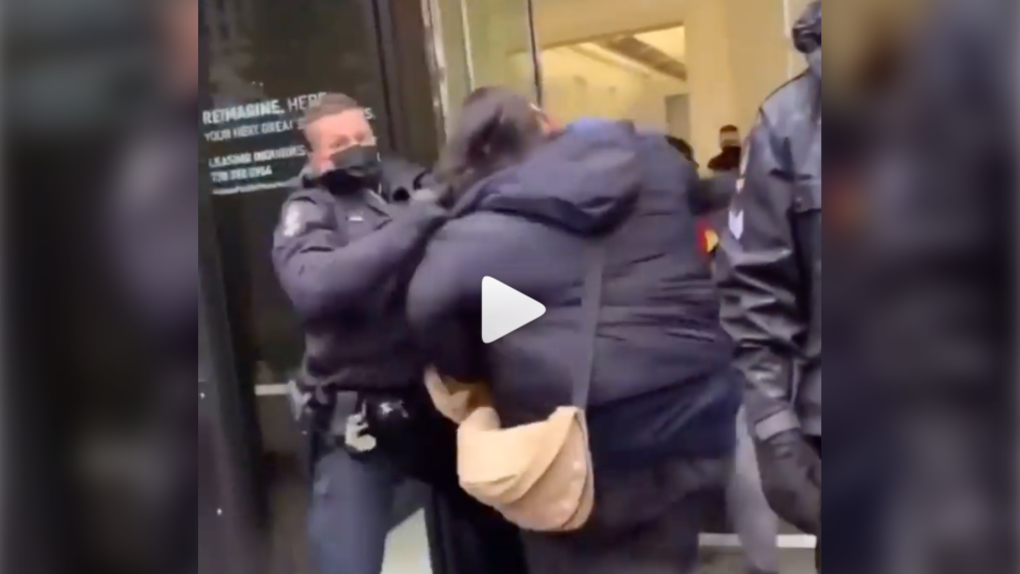Vancouver police officer who pulled Indigenous protester's braid unaware of 'cultural significance': review
 A still image of a video circulating on social media, which appears to have been taken at the Feb. 19 anti-pipeline protest, shows a Vancouver police officer pulling a protester forcefully by the hair (Instagram).
A still image of a video circulating on social media, which appears to have been taken at the Feb. 19 anti-pipeline protest, shows a Vancouver police officer pulling a protester forcefully by the hair (Instagram).
A Vancouver police officer who pulled an Indigenous protester's braid while forcefully removing them from a building acted lawfully, a review found. But training on how to account for "items of cultural significance" in use of force situations is being recommended.
A report coming to the Vancouver Police Board Thursday outlines the circumstances prompting the complaint, the findings of the review by the province's Office of the Police Complaint Commissioner and the recommendations to the VPD.
On Feb. 19, 2021, a group called Braided Warriors occupied the downtown lobby of a building where Trans Mountain pipeline insurer AIG has its offices. Video posted to social media showed the "forceful removal" of several demonstrators "including one officer who pulled the braid of an Indigenous person," the review of the complaint says.
The review was launched the next month and concluded in January of 2022. Commissioner Clayton Pecknold sent the findings – based on an investigation conducted by Metro Vancouver Transit Police – to the Vancouver Police Board in a letter dated April 25.
"The respondent member’s use of force in pulling the Indigenous person’s braid was lawful and in accordance with authorities, training, and policy," Pecknold wrote.
"The respondent member’s evidence was that he was not aware of the cultural significance of the braid and therefore did not consider its significance when he chose to grab the Indigenous person’s braid as a means of removing the individual from the building."
It was that finding that prompted the recommendation that the department review its training, policies and procedures, particularly but not exclusively when it comes to use of force.
"It is apparent that the respondent member’s lack of training and understanding with respect to items of cultural significance in use of force situations was a factor in the conduct that was the subject of this investigation," Pecknold continued.
The Truth and Reconciliation Commission's final report contains multiple accounts from residential school survivors who described having their long, braided hair cut upon arrival, describing it as one of the ways those institutions practiced cultural genocide by trying to erase their identity.
"The assault on Aboriginal identity usually began the moment the child took the first step across the school’s threshold. Braided hair (which often had spiritual significance) was cut," one of the commission's reports reads.
Acting on the recommendation stemming from the review, the report coming to the police board recommends that the department report back on, among other things, the question of how cultural considerations may be incorporated into the use of force policy, "recognizing that use of force encounters are inherently unpredictable, volatile, and may necessitate discretion and unique responses."
The incident that prompted the complaint to the OPCC was condemned by the Union of BC Indian Chiefs and the BC Civil Liberties Association as "horrifying" and "appalling" in a statement issued shortly after the video was posted online.
CTVNews.ca Top Stories

Trudeau acknowledges charges in Nijjar killing, calls for commitment to democracy
Prime Minister Justin Trudeau has acknowledged the charges laid Friday in relation to the murder of B.C. Sikh activist Hardeep Singh Nijjar.
No proof man lied to brother about number of kittens born in litter, B.C. tribunal rules
A man was denied a $5,000 payout from his brother after a B.C. tribunal dismissed his claim disputing how many kittens were born in a litter.
Bodies recovered in Mexico likely 2 Australians, 1 American who went missing: officials
Three bodies recovered in an area of Baja California are likely to be those of the two Australians and an American who went missing last weekend during a camping and surfing trip, the state prosecutor’s office said Saturday.
Princess Anne lays wreath at B.C. veteran's cemetery; receives 21-gun salute
Princess Anne paid tribute to veterans buried at a cemetery in British Columbia today, laying a wreath to honour the more than 2,500 military personnel and family members buried there.
Mystik Dan wins the 150th Kentucky Derby at Churchill Downs in a three-horse photo finish
Mystik Dan won the 150th Kentucky Derby in a photo finish, edging out Forever Young and Sierra Leone for the upset victory.
'I just can't believe that it took so long': Body found in wreckage 3 months after deadly fire
A man accused of arson in a January Old Strathcona apartment fire is expected to be charged with manslaughter after a body was discovered in the burned building late last month.
Quebec police hand out hundreds of tickets to Hells Angels and other bikers before 'first run' meeting
Quebec provincial police handed out hundreds of fines to Hells Angels members and other supporting motorcycle clubs who met for their 'first run' in a small town near Sherbrooke, Que.
Work stoppage possible as WestJet issues lockout notice to maintenance engineers' union
A lockout notice issued by WestJet to a union representing aircraft maintenance engineers could result in a work stoppage next week.
London Drugs begins 'gradual reopening' on 7th day after cyberattack
Almost a week after all London Drugs stores across Western Canada abruptly closed amid a cyberattack, they began a "gradual reopening" on Saturday.































